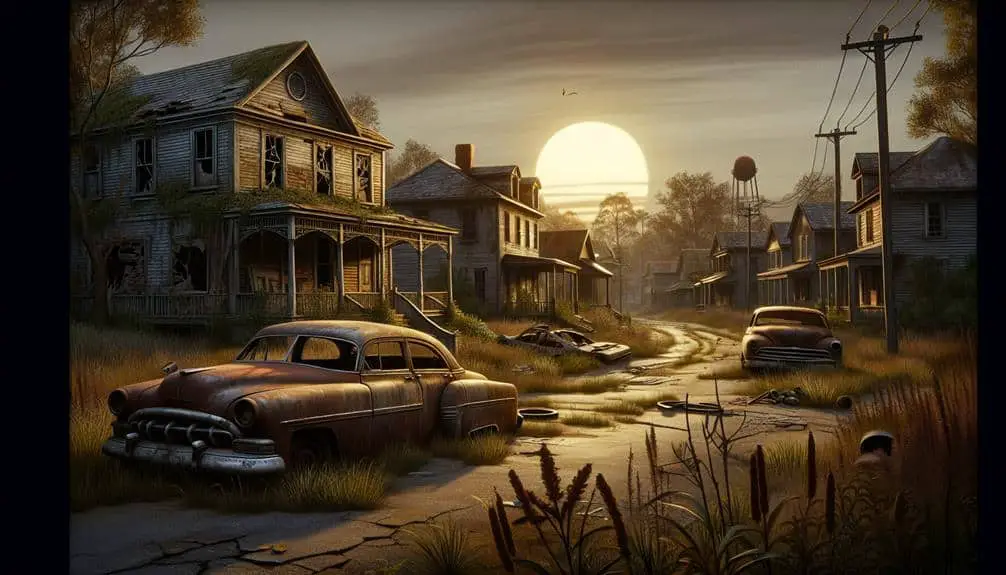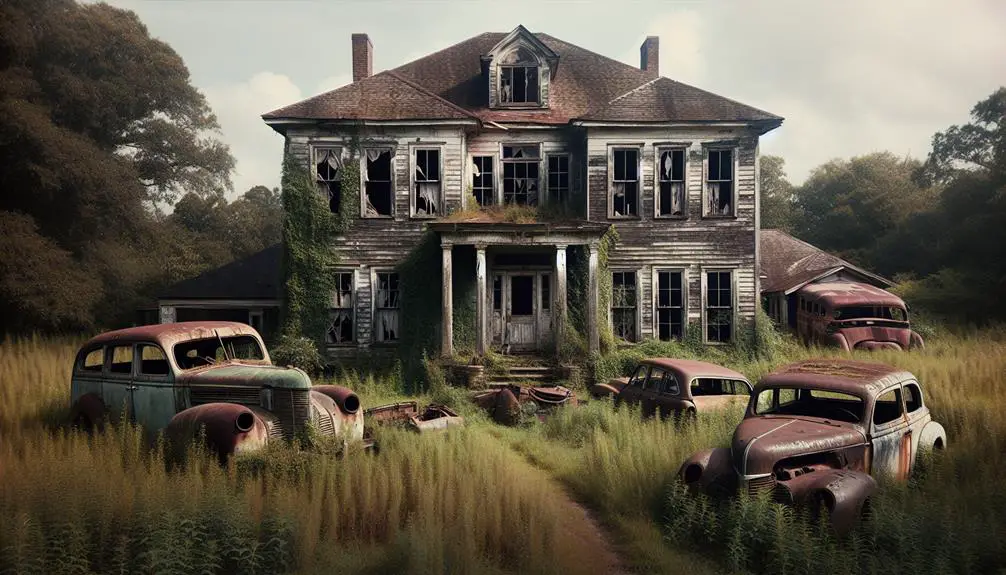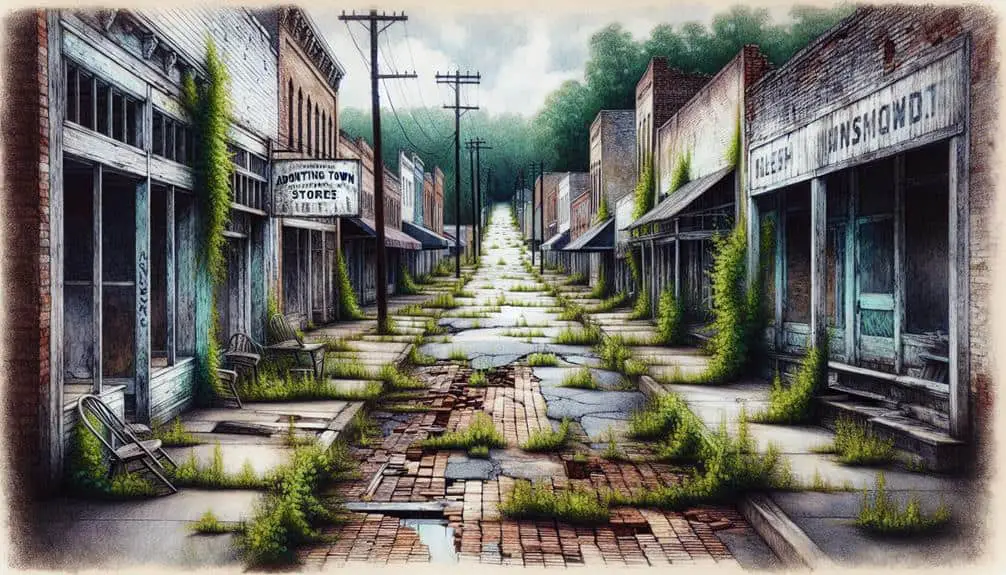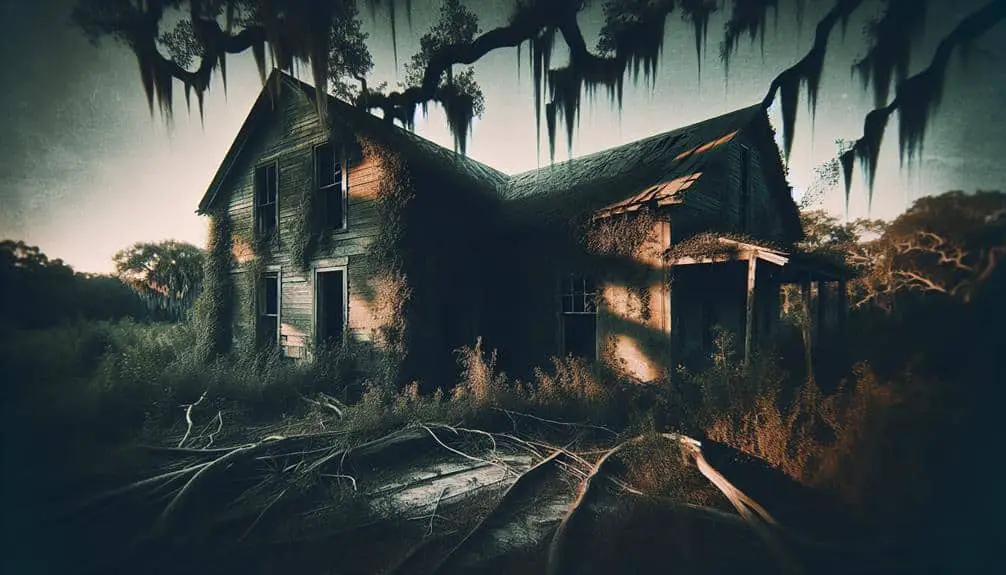In Southern suburban ghost towns, economic decline has left a haunting legacy. Abandoned homes and businesses stand as solemn reminders of bygone prosperity. The streets, once bustling, now echo with eerie silence. Neglect has gnawed at infrastructure, leaving roads in disrepair. Urban sprawl, driven by shifting population patterns, has further exacerbated the desolation. As industries change and jobs dwindle, these towns witness a slow unwinding of community ties. The unsettling atmosphere of these ghost towns reflects a deeper narrative of struggle and transformation. Explore the intricate web of factors shaping their fate.
Key Points
- Economic decline leads to abandoned homes and businesses, contributing to desolation.
- Urban sprawl displaces populations, creating ghost towns and impacting housing demand.
- Industrial changes result in job losses, foreclosures, and community disintegration.
- Neglected infrastructure and lack of engagement worsen the unsettling atmosphere.
- Preservation efforts, community involvement, and historical significance can aid in revitalization.
Economic Decline Impact on Southern Suburbs
Economic decline has ravaged the once-thriving Southern suburbs, leaving behind a landscape of abandoned homes and businesses, shrouded in a veil of uncertainty and speculation. As you walk through these desolate streets, remnants of a vibrant past linger, now juxtaposed with a present marred by neglect and decay. The impact of this economic downturn is profound, affecting not just the physical infrastructure but also the very essence of community life.
Community engagement, once a cornerstone of these neighborhoods, now seems like a distant memory. The bustling markets and lively gatherings have given way to eerie silence, a stark reminder of the toll economic hardships can take on social bonds. Without the vibrant interactions that once defined these areas, the sense of unity and belonging has eroded, leaving residents feeling isolated and detached.
Infrastructure development, once a sign of progress and prosperity, now stands neglected and forgotten. Crumbling roads and dilapidated buildings serve as stark symbols of a once-thriving economy brought to its knees. The lack of investment in essential services has further exacerbated the challenges faced by residents, creating a cycle of decline that seems difficult to break. As you ponder the future of these Southern suburbs, the need for revitalization and renewed focus on community well-being becomes increasingly evident.
Factors Contributing to Urban Sprawl
As urban populations grow and demands for housing increase, the expansion of residential areas into previously undeveloped land accelerates, fueling the phenomenon known as urban sprawl. This continuous outward growth of cities is influenced by several interconnected factors:
- Transportation Infrastructure: The development of highways and roads makes it easier for people to live further away from city centers, leading to the spread of communities into rural areas.
- Zoning Regulations: Flexible zoning laws often prioritize economic development over environmental conservation, allowing for the construction of residential areas in previously protected lands.
- Land Use Policies: Inadequate land management practices can result in the inefficient use of space, encouraging the outward expansion of urban areas.
- Environmental Degradation: Urban sprawl contributes to habitat destruction, loss of biodiversity, and increased pollution levels, leading to long-term environmental consequences.
These factors collectively contribute to the sprawling nature of urban areas, impacting both the environment and the quality of life for residents.
Shifts in Population and Migration Patterns
The expansion of residential areas due to urban sprawl prompts a reevaluation of population distribution and migration trends, shedding light on the evolving dynamics of community settlement patterns. Demographic shifts play an important role in the transformation of once-thriving suburban neighborhoods into ghost towns. As populations migrate towards urban centers for better economic opportunities, these suburban areas experience a decline in residents, leading to vacant homes and deserted streets. Housing trends reflect this shift, with a surplus of available properties in these suburban regions as demand dwindles.
Community development and infrastructure changes are deeply impacted by these population movements. Local businesses struggle to survive as their customer base diminishes, resulting in closures and abandoned commercial spaces. The lack of community engagement further exacerbates the situation, contributing to the overall desolation of these once-vibrant neighborhoods. As demographic patterns continue to evolve, it's essential to closely monitor these shifts to understand the underlying causes and potential solutions for revitalizing these southern suburban areas.
Effects of Industrial and Economic Changes
Amidst the changing industrial landscape and economic fluctuations in the southern suburban regions, a noticeable impact on community vitality and resilience emerges. The effects of the industrial revolution and subsequent housing crisis have left lasting imprints on these once-thriving areas. Here are some key points to ponder:
- Decline in Job Opportunities: As industries shifted or closed down due to economic changes, employment options dwindled, leading to job losses and financial instability in the communities.
- Housing Market Instability: The housing crisis resulted in foreclosures, plummeting property values, and a lack of affordable housing options, forcing many residents to relocate.
- Community Disintegration: With the loss of jobs and stable housing, social networks fractured, community bonds weakened, and a sense of belonging eroded over time.
- Strain on Local Services: The sudden population shifts and economic challenges strained local services such as schools, healthcare facilities, and law enforcement, further impacting community well-being.
These factors have contributed to the unsettling phenomenon of southern suburban ghost towns, where once vibrant neighborhoods now stand as remnants of a bygone era.
Preservation Efforts and Future Prospects
Efforts to preserve the historical integrity and potential revitalization of these southern suburban ghost towns are essential for shaping their future prospects. Community engagement plays a vital role in these preservation efforts, as it fosters a sense of ownership and responsibility among residents and stakeholders. By actively involving the community in restoration projects, there's a higher likelihood of success in preserving the historical significance of these ghost towns.
Moreover, historical significance serves as a cornerstone for the future prospects of these areas. Understanding the past allows for a more informed approach to revitalization, ensuring that any development respects and honors the heritage of the community. By acknowledging the unique history of these ghost towns, there's an opportunity to attract visitors interested in heritage tourism, further contributing to their economic and cultural revival.
Frequently Asked Questions
What Are Some Common Myths or Legends Surrounding the Ghost Towns in the Southern Suburbs?
Urban legends and folklore in southern suburban ghost towns often revolve around haunted stories and supernatural occurrences. These tales entice with mystery and intrigue, drawing you in with the promise of uncovering hidden secrets and eerie happenings.
How Do Local Communities View and Interact With the Abandoned Buildings in These Ghost Towns?
You see abandoned buildings differently; Community perceptions vary widely. Some cherish architectural preservation, seeing beauty in decay. Others fear ghostly remnants, shunning these structures. Balancing history and progress, your town's identity hangs in the balance.
Are There Any Reported Paranormal Activities or Sightings in These Southern Suburban Ghost Towns?
Perplexed by the paranormal? In these southern suburban ghost towns, reports of haunted sightings and urban legends are aplenty. Paranormal investigations stir up ghost stories that echo through the abandoned streets, fueling curiosity and fear.
What Are Some Unique Features or Landmarks Found in These Abandoned Areas?
Explore the remnants of forgotten neighborhoods where unique architecture stands frozen in time, offering glimpses of a bygone era. Among the ruins lie hidden treasures awaiting discovery, echoing the untold stories of those who once called these places home.
How Have These Ghost Towns Influenced the Cultural Identity or History of the Southern Suburbs?
As you stroll through the remnants of these forgotten towns, you feel the weight of their cultural impact and historical significance. The empty streets whisper stories of a past that still lingers in the southern suburbs.



